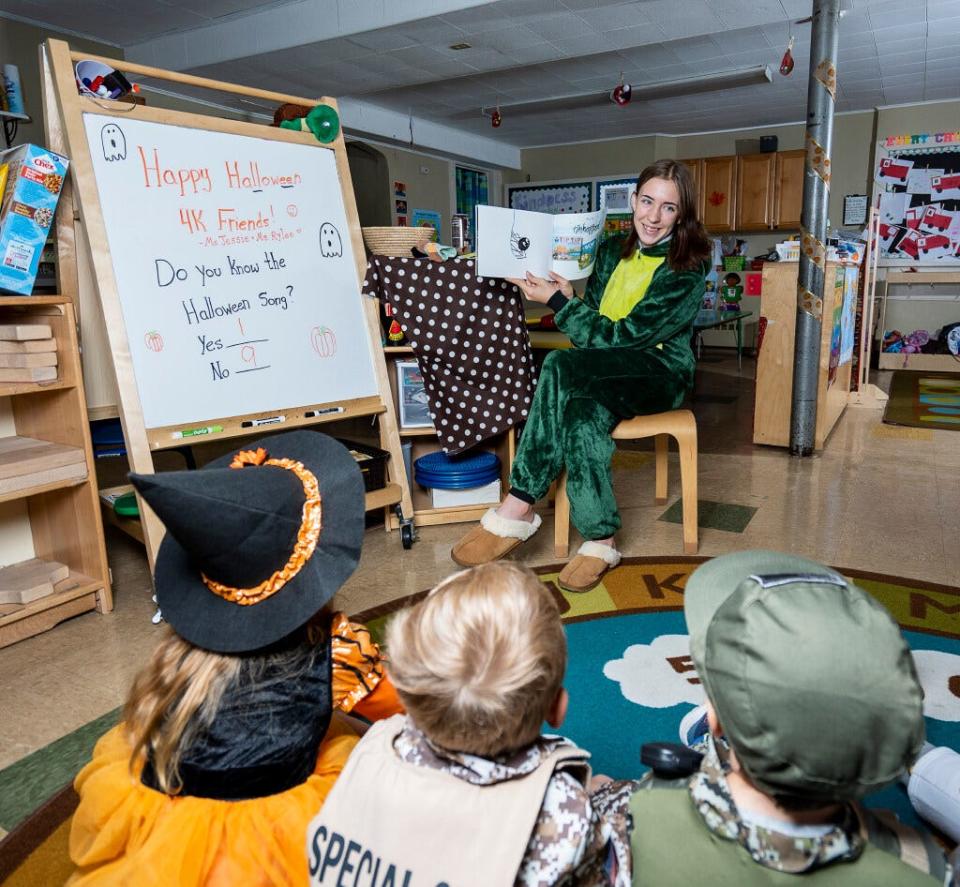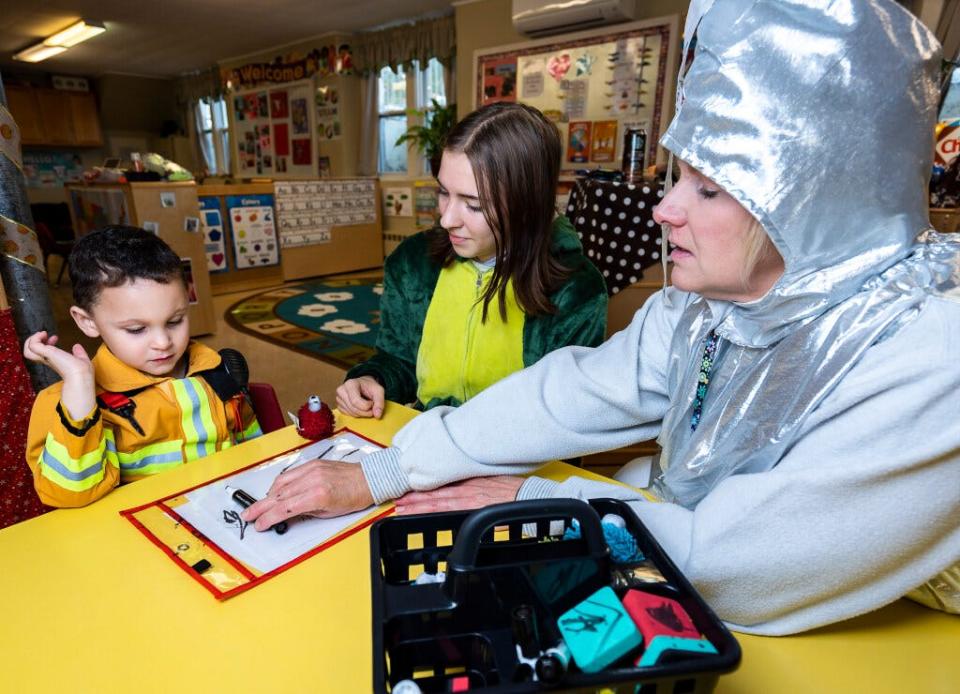Can apprenticeships be the key to solving child care issues?
Most days of the week, high school senior Rylee Dickinson begins her day in a room filled with young children.
Like her coworkers at Community Care Preschool and Child Care Inc. in Beaver Dam, Dickinson guides toddlers and 4-year-olds through snack times, potty training and more. But after her 7 to 10 a.m. shift, she heads back to Beaver Dam High School.
Dickinson is one of Wisconsin’s first high school students earning school credit while working in a child care center. New this fall, this youth apprenticeship program complements a growing registered apprenticeship program in the same field designed to lead to an associate’s degree. Both apprenticeships are administered by the Wisconsin Department of Workforce Development.
The child care programs that host apprentices often see them as a way to help a field marked with challenges, such as staffing shortages. Federal data from 2022 show the median hourly wage for a child care worker was $12.66. Most child care jobs don’t come with health insurance.
Increasing compensation to attract and retain more teachers isn't so simple: Child care centers often have few revenue sources, so increasing pay would likely mean charging parents more for care at a time when it's already unaffordable for many.
And while apprenticeships may not be a silver bullet solution to such problems, some say they are a tool for investing in highly trained, committed employees in an industry that often receives little appreciation.
Youth apprenticeship designed to connect high schoolers to child care employers, related classes

For Dickinson, the question is not whether to work with kids. It's how old they are.
Ideally, working at the Beaver Dam child care center will help her decide. That’s essentially the goal of the youth apprenticeship: to give high schoolers real-world experience to shape their career choices. Youth apprentices must complete 450 hours at their job site per year, which can take place during school hours, plus take classes related to their job and meet specific learning targets outlined by the state.
How many high schoolers fill jobs in child care centers will depend on demand for the program. Youth apprentices are able to work as either an early childhood program aide or assistant teacher, assuming they are at least 16 or 17 years old, respectively, and meet specific state requirements.
It’s up to schools and consortia — local groups that oversee youth apprenticeships — to develop relationships with local employers and help students meet program requirements.
Along with building confidence, Dickinson said the apprenticeship has given her a better sense of what a child care worker’s job entails. It’s not just about taking care of kids, she said — it’s about meeting individual kids’ needs.
“It’s one of those things that you don’t fully understand until you’re put into that situation,” she said.
More: How Wisconsin youth apprenticeships work, and what's available

For registered apprenticeship, employers agree to pay for apprentices’ class time for associate’s degree
In 2020, the early childhood education registered apprenticeship launched with three child care centers and seven apprentices. As of this year, 10 people have completed the program and another 24 apprentices are currently working across 12 centers.
Registered apprentices in early childhood education must spend 2,000 hours on the job while working toward a technical diploma in child care services. Any current or prospective child care worker can join, assuming they have a high school diploma and meet other pre-existing state Department of Children and Families requirements.
Child care centers aren’t legally required to pay college tuition, but most choose to. They must, however, pay apprentices an hourly wage for time spent in class.
Jessica Bocklund, 33, has been working at the Academy of Little Vikings in Mount Horeb for five years as a lead teacher in the toddler room. It wasn’t until hearing about the apprenticeship that she considered getting a degree in the field, she said.
Now as a registered apprentice, Bocklund is earning a degree from Northeast Wisconsin Technical College while working at the center.
The Mount Horeb child care center is supporting two apprentices this year. Its owner, Brenda Moore Fritz, said she would have been able to pay for only one if it weren’t for being able to help cover degree costs via the T.E.A.C.H. Early Childhood Wisconsin scholarship.
“With the scholarship we can have as many (apprentices) as we can find, really. We still pay extra wages and make time for teachers to work on coursework while at the center; the tuition and books paid for by the scholarship is a huge key to making this program work," she said.
In total, Bocklund is paying for about 5% of the degree.
For early childhood teachers, obtaining higher education improves their skills and can lead to higher pay, Moore Fritz said. Gina Paige, DCF's communications director, added it can also open more employment opportunities.
“I encourage our teams to obtain more continuing education, and if possible a degree in early childhood education, not only for the benefit of the children and families, but (also) for the personal gain,” Moore Fritz said.
More: Wisconsin health care organizations invest in apprenticeship programs to help fill vacancies
How are apprenticeships helping the child care industry?
The problems facing the early care industry are complex, but some say apprenticeships can be one part of the solution.
Take short staffing, just one battle most Wisconsin child care centers are fighting. Because Wisconsin has staff-to-child ratio requirements to help ensure the safety of children in care, short staffing often results in centers having to serve fewer children.
David Polk, director of the Bureau of Apprenticeship Standards, said the registered apprenticeship is a tool that can help.
“As we onboard more of these individuals, that helps the greater community because if we have more teachers, more apprentices in the classroom, those child care centers can take on more (children),” Polk previously told USA TODAY NETWORK-WISCONSIN.
The early childhood program aide position used in the youth apprenticeship does not count toward that ratio, however. Program aides are also not allowed to supervise children alone; assistant teachers can do so only under specific circumstances and if they are at least 18.
Even with such limitations, youth apprenticeships can help by lessening teacher burnout and better serving children needing one-on-one attention.
Renae Henning, administrator for the Beaver Dam child care center, sees youth apprenticeship as a way to build future teachers.
“If we want to do a cost-benefit analysis, investing in somebody like Rylee, and investing in this program, and investing time (is worth it) — I strongly believe that’s my role as a director in child care, to cultivate the next crop of teachers,” Henning said.
For the Academy of Little Vikings, the registered apprenticeship is a way to invest in the workforce it already has. Its current apprentices were working at the center even before Moore Fritz approached them about the apprenticeship.
Bocklund said her apprenticeship has made her a better teacher. Since starting, Bocklund has been promoted to a wing lead position and oversees curriculum for infants and toddlers.
Moore Fritz said she’s seen several educators use T.E.A.C.H to get degrees. She also pointed to the apprenticeship’s built-in safeguards to reduce turnover and help professionalize the position: requiring apprentices spend a year on the job, getting paid for class time and receiving bonuses, for example.
“We can complain all day about how we can’t get enough staff in these centers. But I want to switch the game and say, ‘Let’s try to retain the staff we do have, and let’s try to make them better,’” Moore Fritz said.
For more information on apprenticeships, contact the DWD.
Madison Lammert covers child care and early education across Wisconsin as a Report for America corps member based at The Appleton Post-Crescent. To contact her, email mlammert@gannett.com or call 920-993-7108. Please consider supporting journalism that informs our democracy with a tax-deductible gift to Report for America.
Cleo Krejci covers higher education, vocational training and retraining as a Report For America corps member based at the Milwaukee Journal Sentinel. Contact her at CKrejci@gannett.com. Follow her on Twitter @_CleoKrejci.
This article originally appeared on Milwaukee Journal Sentinel: Can apprenticeships help solve issues in the child care industry?

